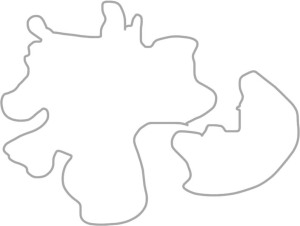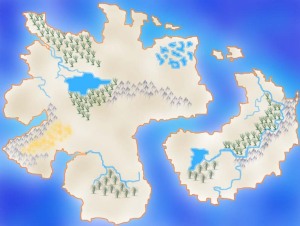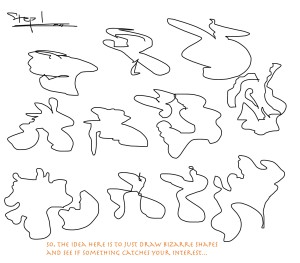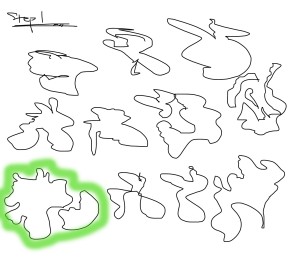Okay, so after taking a break and reflecting on my last post a bit, I feel that this information, to date, is probably pretty standard stuff—sorry if I have been boring you. Tonight I am going to work on getting the geographical landforms illustrated on the map and then, possibly, getting some of the locations placed and named. For the remainder of this map-making extravaganza, I have decided upon the two land map. It makes the most sense for these purposes for some reason.
So, I think it is time that we give out lands a name…something that rolls off of the tongue and it easy enough to pronounce. I cheated with my actual campaign setting, Kildaire, as it is a county in Ireland. Not a lot of people in my neck-of-the-woods know that though, so I went with it. For these purposes let us call the lands Tahqua.
So, as I look at the very general outline of Tahqua, the first thing that comes out is that it really needs some definition—some nooks and crannies and isthmuses and jetties or fjords.
So here is the outline from the original thumbnail drawings.

Now it is time to lay your paper over top of these shapes and make it more interesting…or add a new layer in Photoshop. I will illustrate my overlay in orange because it is my favorite flavor, except in Kool-Aid terms, then its green. Please notice a few things that may be considered ‘drastic’ changes to the perimeters…I do this mainly because I am a huge fan of plate tectonics and I like my lands to look like they may have, at one time, been one larger continent…again, Pangaea anyone?

Now that we have the lands set, it is time to get rid of the original, inspiration-granting thumbnail and get down to aquatics, flora, climatic oddities, etc. Because I am doing this in Photoshop, I found a few neat brushes that will help with the mountains and the trees—olde schoole map icons like ^ for mountains and the cloud-like trees with line trunks are totally acceptable (that is how I illustrated Kildaire).
So let me start with water features…I tend to favor lakes and rivers and the likes so my maps are typically heavy with these sorts of things. I will hold myself back a bit for this though. Not only do I just love the imagery that water can offer to a role-playing session but also there is the very real fact that it is just so much easier for the players’ transportation.

As you can see I have several major rivers, a mammoth lake and the area of 10 lakes. Remember that you map does not have to include every detail of the geography for your players…they should not be handed everything. It is nice to surprise them with a giant marsh where a sparse forest should be. Typically I just start drawing pretty freely with my rivers and there is little rhyme or reason at this point as to why I place them where I do. It helps to keep your mind open at this point and let things happen organically if possible. That being said, most of us have at least one ‘really cool’ land feature that we have to have…go for it! What I like most about the organic development is that it can really help you come up with interesting locations to explore. While I am writing this, I keep looking at the 10 lakes area and I am asking myself why are they there? Perhaps it is a very rocky, hilly area and they are present for lack of drainage. That works…meh. However, what if they were a series of ‘craters’ for lack of a better term, and they are all interconnected underground. Now, that means they can be home to very cunning dragons that use the underground waterways as a labyrinth to confuse their prey. To me, that is much more interesting.
For me, the next step is adding mountains. I like to get my elevation set early as it affects some of my later decisions (namely deserts). Again, going off of the plate tectonics interest, I typically have coastal elevation, which would be the cause of colliding plates forcing the earth upwards. This time it is not as extreme but there is still subtle influence.

So three mountain ranges have been established and they are all substantial stretches of difficult terrain. Please remember that fact; mountains = difficult terrain. That slows travel, possesses great threats to the characters, and makes for wonderfully well-defended strongholds. You can also add any number of mountain rivers that are sourced from snow melt as well. I will also note here that where there are mountains, there are foothills. I typically illustrate hilly areas but to keep this simple and clean I am going to leave them off.
After the elevation comes the vegetation. Typically I have several large stands of forest and they vary from coniferous to deciduous. I love large stands of Jack Pines, where the lower branches die off and create an open, easily traversable area for characters. I also favor sugar maples due to the intensity of fall colors, which can create very dramatic imagery for gaming.

Notice how I have 2 different tree icons in place—these can represent either coniferous versus deciduous trees of they can be used more literally as being spooky willow trees and barren hardwoods…its totally up to you.
Now, as I mentioned a bit earlier in the mountain section, I like to use my mountains to create interesting climactic issues. For this last portion of mapping, I am going to use the westernmost mountains to create a rain-shadow, or absence of rain, which will produce a desert area. Deserts offer a totally different aspect to gaming—an aspect where survival is pushed to the Nth degree. I played in an online, homebrew setting where the animals could smell fresh water for miles away and they were upon that smell in minutes. It was devastatingly difficult and frustrating as your character could very well risk their life for taking a drink (which was probably being taken to avoid risking their life).

That is, pretty much, establishing your terrain for a continent. Please do not feel like this is all that you can do because the possibilities are endless. In a fantasy setting, anything is possible and this will become extremely apparent when I show you Kildaire, Land of the Five Ashes where there is a two-tiered ocean, which separates Kildaire (the mortal continent) from The Land of the Five Ashes (the home of the gods).
The only thing left for this map is to add some underlying color for the oceans and for the land. This is extremely simple in Photoshop so here is my final product for this phase of WBing. There is a distinct lack of a compass indicator as well as a distance key on this map. I am going to leave that up to you for now. I have always used the very simplistic rule that ‘North is Up’ and, for these purposes, distance is not an essential element right now.

Roll your Spot checks now as I will be coming back soon with cities and named landforms amongst other things which really get us into the meat and potatoes of WBing!














